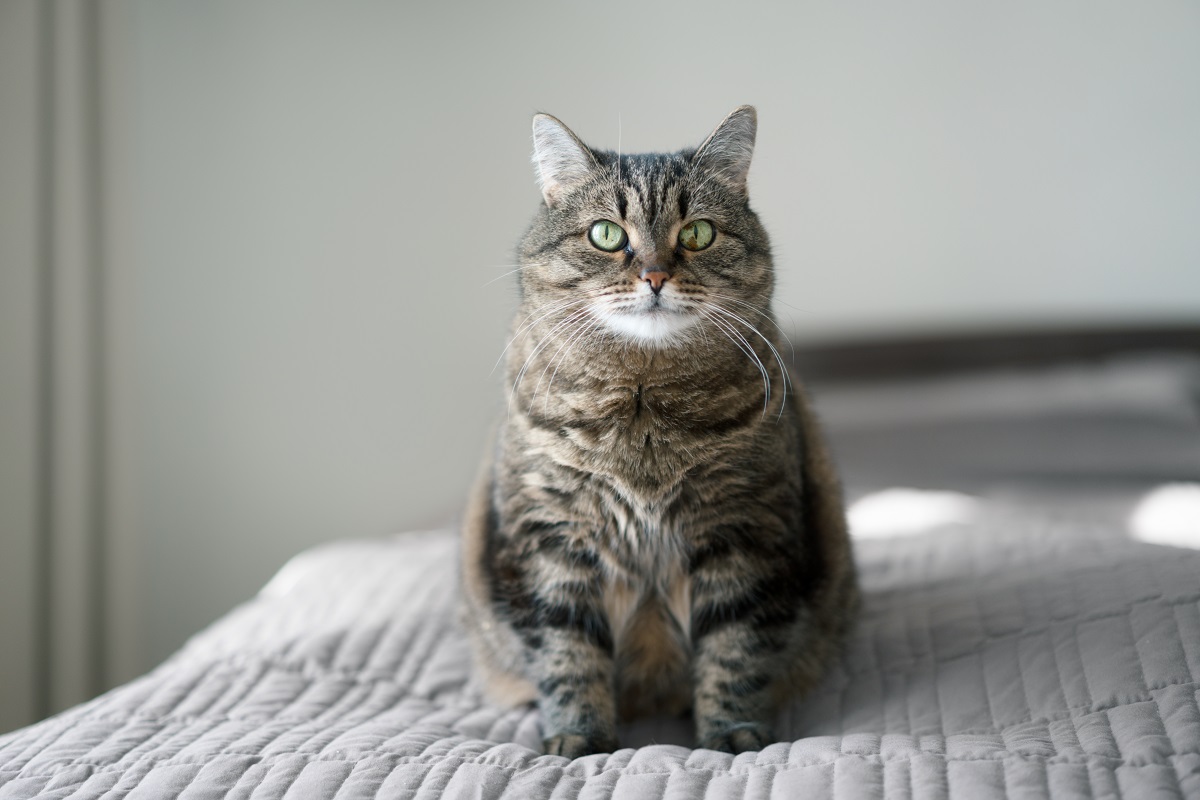Written by: Allison Ward
Perhaps you noticed your favorite feline moving more slowly than usual, having difficulty making or landing jumps onto their favorite places, or spending more time in sleeping spots on the ground instead of up high. You’ve taken her to your family veterinarian, who may have taken some x-rays of her joints, and your kitty has been diagnosed with arthritis. Now what?
Most cat owners are unaware that arthritis is a VERY common disease in cats—especially older cats! Veterinarians and cat lovers are recognizing arthritis in kitties at a higher rate than ever before, likely because our pet cats now live longer than ever thanks to excellent wellness care throughout their life. Sadly, though, there’s only so much you (and your veterinarian) can do to prevent arthritis in the first place . On the good side? There are many options to relieve cat arthritis symptoms and help your cat live as long as possible with a pain-free and active life—even with arthritis!
Weight Control
The number one MOST EFFECTIVE cat arthritis treatment is to make sure they are lean and with a healthy body condition! Wait, how can this be?
Think about the amount of pressure on your cat’s joints while they are walking, running, and especially when they land from a jump. Even one extra pound of body weight can increase the pressure on her joints tremendously during all of these activities. The opposite is also true: less weight equals less pressure, and therefore less pain.
If your cat is overweight at the time of their arthritis diagnosis, congratulations! Although it’s difficult to help a cat lose weight, you have a safe way to drastically improve your cat’s quality of life, and to reduce the need for the other therapies we’ll discuss in this article.
Talk to your veterinarian for tips on how to get your cat to lose weight and create a personalized weight-loss program. Since increasing exercise (and thus calorie burn) in patients with arthritis is always challenging, your veterinarian may want to switch your cat’s diet to a prescription calorie-reduced formula to make the weight loss process more successful. Some of these foods have the added benefit of fatty acids and other beneficial joint supplements, too!
Joint Supplements
You’ve most likely heard that joint supplements are effective for people trying to preserve the health of their joints and their mobility. The same is true for cats! Joint supplements work to preserve the smooth slippery fluid within your cat’s joints and the health of the soft cartilage shock-absorbing joint surfaces. These supplements are best started when your cat still has normal tissue to preserve and maintain. If your cat is a breed likely to develop arthritis (like Scottish Fold and Maine Coon cats), or has had a joint injury (including surgery) in the past—then starting joint supplements and continuing them for the rest of your cat’s life may be a good idea.
Most of these long-term joint supplements are taken by mouth. They may come in tasty chewable treats, a liquid that you squirt on your cat’s food every day, or a capsule that you open and sprinkle the flavored powdery contents on your cat’s food. Some prescription diets formulated specifically to maximize joint health contain high levels of these joint supplements—reducing the number of steps you need to take each day!
If your cat already has arthritis, a special form of joint supplement is available in injectable form. This is called Adequan, and helps to preserve joint health and also actively reduce some of the pain and inflammation that comes from arthritis! Adequan is available by prescription only, and your veterinarian can teach you how to administer the injections at home. (We promise, it is easier than it sounds!) Injections are typically twice weekly to once a month, and are very safe for your precious purrbox.
Pain Medication
Once a cat’s quality of life is being affected by arthritis, pain medication becomes essential to help him live his best life. Anti-inflammatory medications are often used in both dogs and cats for arthritis pain, but the way veterinarians use them for cats is a bit different!
In general, veterinarians are more cautious about the long-term use of anti-inflammatory medications in our feline patients. While this class of medication (which includes Onsior and Meloxicam/Metacam) can make a dramatic improvement in the lives of many cats, and slow the progression of arthritis, restrictions on the prescription labeling for these drugs generally prohibit their daily long-term use. Instead, your veterinarian may recommend using one of these medications every other day, or several times a week, depending on your cat’s needs. Your veterinarian will likely want to perform blood work before and during long-term therapy with this class of medication.
There are other pain medications available for cats whose kidneys are already struggling to function, or in cats for whom regular bloodwork monitoring isn’t possible, or in cats for whom anti-inflammatory drugs and joint supplements just aren’t enough to control their pain. These medications include gabapentin (which is wonderful for all types of chronic pain), buprenorphine, and Cerenia (maropitant). These medications can be used on an as-needed basis for arthritis flare-ups, or on a daily basis, depending on your kitty’s needs.
AskVet Tip: As veterinarians, we are all too aware of how intimidating it is to give your
cat medication—especially if it is a medication that she will potentially need every day
for the rest of her life! Fortunately, there are many options for cats who are difficult to medicate. Joint supplements often come in flavored treats. Your veterinarian can prescribe a special flavored liquid, chew/treat, or miniature tablet of their chosen pain medication through a special compounding pharmacy. You can also train your cat to associate medicine time with happy time! (Ask us how!) Yes, it is possible for your cat to LOVE receiving her medications!
Other Treatment Modalities
In addition to pharmaceuticals and nutraceuticals, there are other ways to manage your cat’s arthritis pain. Some veterinarians are specially trained in acupuncture, which has been proven to help feline pain in a similar way to how it helps humans! Not all veterinarians are trained in acupuncture, but your family veterinarian likely knows a colleague with this special skillset and can refer you and your kitty.
Laser therapy, which consists of a focused beam of light to help inflammation within specific joints, can also be used on problem areas to increase your cat’s mobility and comfort. Many family veterinarians now offer this service, which is non-invasive and can be quite effective.
Not all cats are amenable to rehabilitative therapy, but if you suspect your cat would tolerate or enjoy taking walks on a treadmill or going through flexibility and strength-training exercises with a rehabilitative therapist, ask your family veterinarian for a referral to a local colleague who performs these services. Just like in people, physical therapy can make a HUGE difference in cats with mobility problems!
Environmental Modification
At home, it’s important to recognize that your beloved feline needs a little extra help in reducing pressure on their joints and in accessing their favorite places. Here are a few ideas to maintain his physical and mental health:
–Make sure he has a comfy bed to sleep on that is easy to climb into—there are many orthopedic pet beds on the market today! Just make sure the sides are nice and low.
–Assess your litterbox location(s): litterboxes for arthritic cats should be easily accessible on the floor and NOT require your cat to jump up in order to use the bathroom. If your litterbox has high sides that require your stiff kitty to climb in to relieve themselves, consider a shallow litter tray instead—or modify the entrance to his box by cutting an entry hole that only extends up to two inches above the floor. (Just make sure to smooth out any cut edges to prevent injury.)
–Use pet stairs or pet steps next to your bed, couch, or other favorite sleeping spot to make it easier for your cat to enjoy his favorite places with minimal joint stress and pain
–Consider placing a low chair, stool, or other surface near a favorite cat tree so that he can more easily gain access to the upper levels by jumping on that piece first!
The Bottom Line
From simple things you can help your cat with at home (such as weight loss and improving accessibility to favorite places), to joint supplements, to daily medications—there are many ways to help your cat with arthritis pain! If you’d like to know more about any of these options, or to discuss whether your cat’s symptoms might be due to arthritis, chat in with our AskVet veterinarians 24-hours a day, 7-days a week. We are always here to help you and your pet!
Written by:
Allison Ward, DVM
Dr. Allison Ward grew up in the suburbs of Washington, D.C. and started working in veterinary hospitals when she was 14 years old. After graduating from veterinary school in 2011, she completed a small animal rotating internship in New Jersey, followed by a neurology/neurosurgery internship in Miami. After completing this advanced training, Dr. Ward then moved on to general small animal practice. Dr. Ward’s professional interests include feline medicine, neurology, and pain management. Her passion for educating pet owners carries over into her work with AskVet, and she loves being able to help pets and their parents at all times of the day (and night!). She currently resides in sunny south Florida with her two cats, Larry and George.








